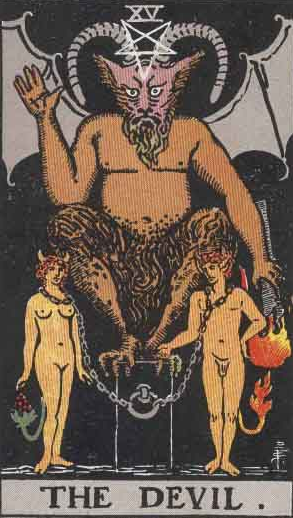

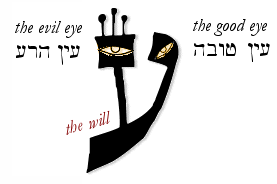 The Talmud (Shabbat 104a) describes the letter Ayin as having two eyes. The good eye looks toward the preceding letter, Samech (support, Temperance) and manifests benevolence and charity. Remember that Hebrew is written right to left.
The Talmud (Shabbat 104a) describes the letter Ayin as having two eyes. The good eye looks toward the preceding letter, Samech (support, Temperance) and manifests benevolence and charity. Remember that Hebrew is written right to left.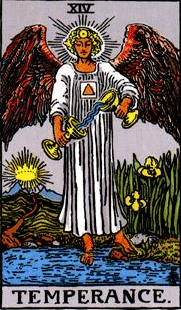 The bad eye looks toward the next letter, Pey (mouth) and manifests greed and envy, which will eventually lead to destruction (The Tower). The
The bad eye looks toward the next letter, Pey (mouth) and manifests greed and envy, which will eventually lead to destruction (The Tower). The 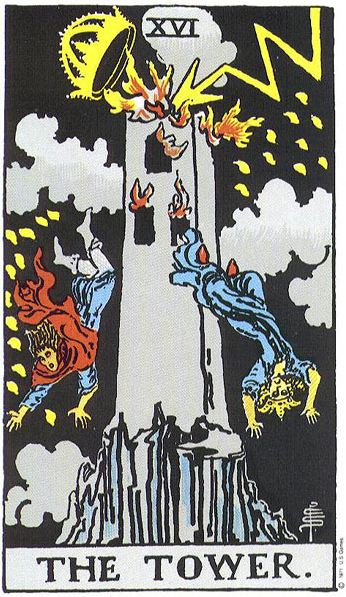 Devil does everything he can to convince us to look toward The Tower, because this way limits us to physical reality and blinds us to the comfort and power of the divine that is constantly with us.
Devil does everything he can to convince us to look toward The Tower, because this way limits us to physical reality and blinds us to the comfort and power of the divine that is constantly with us.
Capricorn is the astrological sign attributed to The Devil. It is the sign of the sea goat, a strange looking animal with the head and body of a goat and the tail of a fish. The constellation of Capricorn has been called The Sea Goat since the Bronze Age, so Capricorn’s beast is the sea goat. No one really knows what a sea goat is, but this doesn’t keep people from speculating. At least the sure-footed, mountain climbing goat part is appropriate to both The Devil and Capricorn natives, who are practical, grounded (it’s an earth sign), and goal oriented. They are masters of politics and the systems of the material world.
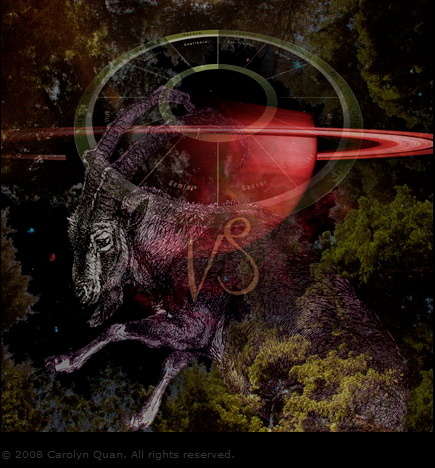
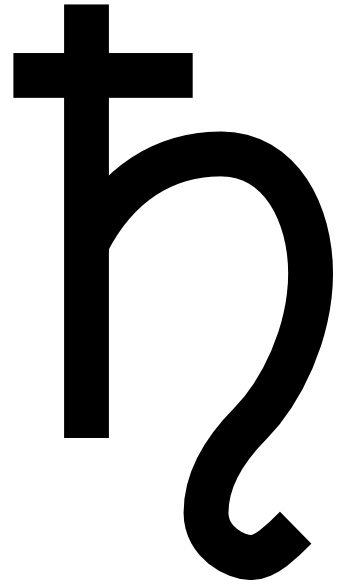 Saturn, the planet of boundaries, limitations and lessons rules Capricorn.
Saturn, the planet of boundaries, limitations and lessons rules Capricorn.
When The Devil comes up in a reading it often means that the querent is bogged down in practical problems and things are looking bleak. But this key reminds us that our belief in our misfortunes is The Devil’s illusion. Money may be scarce, or we may be killing ourselves with too much work, or we may have just been diagnosed with cancer, but if we are able to look past the immediate problem and tap into the powerful, invisible forces at work in the Universe, a miracle happens. It may be as simple as realizing that things aren’t as bad as we thought, or as profound as a cancer cure, but it will happen. What we see is not all there is. With faith, amazing things are possible. When we loose faith, The Devil has us in his clutches.
Depending on its placement and the cards around it The Devil can mean solving problems with logic and practicality. But it can also 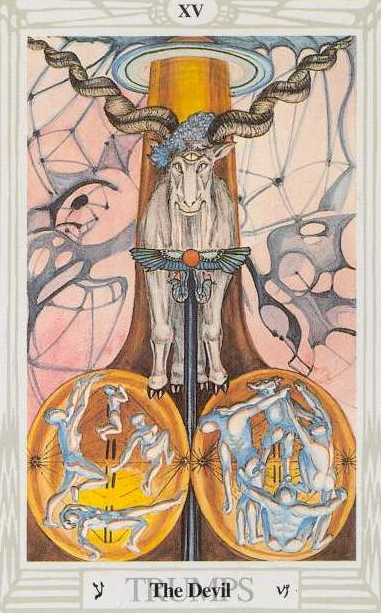
Occasionally it becomes obvious that the querent himself is the devil, binding someone else to the material world and/or keeping her from progressing spiritually or emotionally. He may be doing this out of greed, jealousy, or fear of abandonment.
Now that we have some understanding of what The Devil is, the million dollar question remains: Does he really exist?
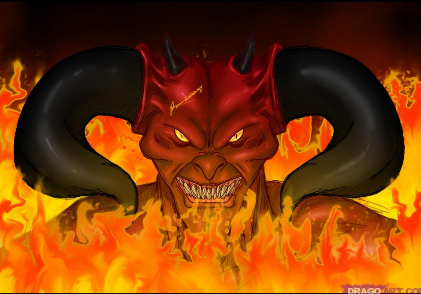
We certainly speak of him as if he does, which, in a sense, makes him real. But there is no solid evidence for his existence. I haven’t decided whether or not I believe that there is an entity of pure evil stalking through the universe and corrupting all that is good and worthwhile. Some days I’m am quite ready to believe he’s out there. But when the sun shines and the flowers bloom and people are smiling, I’m sure he was just a figment of my fevered imagination.
Psychologically, The Devil exists in all of us. He is our Shadow, the part of us that questions authority, wonders whether the status quo is really the only quo there is, wants to play on a beautiful day instead of work, and would love to smack that self righteous idiot in the face with a pie. It is also the part of us that can’t understand why it’s not OK to kill the bastard in the car in front of us who just cut us off.
As The Shadow, The Devil lurks in every archetype in The Hero’s journey. He is the part of the Hero that has fears and doubts about the journey—some of which are quite valid. The part that has desires for things she knows will harm her or keep her from succeeding in her quest. This is the same Devil we battle every day of our lives and we have sympathy for her as she struggles against him.
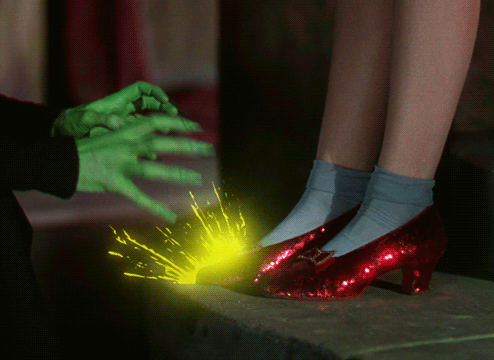 The Devil really shines in the antagonist. Like all of us, the villain has a shadow, but he becomes a villain when his shadow side takes total control. The Wicked Witch of the West’s shadow wanted the ruby slippers and all the powers that they would give her. A normal desire. After all, they belonged to her sister. But when she allowed her shadow side to take over and set fire to the Scarecrow, etc., etc, she became a most excellent villain.
The Devil really shines in the antagonist. Like all of us, the villain has a shadow, but he becomes a villain when his shadow side takes total control. The Wicked Witch of the West’s shadow wanted the ruby slippers and all the powers that they would give her. A normal desire. After all, they belonged to her sister. But when she allowed her shadow side to take over and set fire to the Scarecrow, etc., etc, she became a most excellent villain.
But very few fictional characters can actually be described as The Devil. The Devil appears as himself in many works of fiction–The legend of Faust comes to mind, but that’s different. The following two villians are the only ones I can think of who truly approach Satanic. Can you think of others?
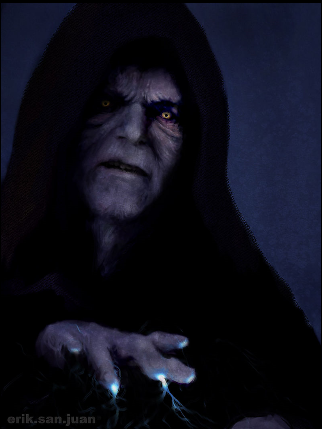
The Emperor in Star Wars could actually be The Devil. Like The Devil, he has unimaginable power and is trying conquer the entire Universe. Through deception and half-truths he turns young Anakin Skywalker to the dark side and so gains total control over him.
There are two very nasty villains in The Lord of the Rings trilogy, but again, they are powerful men who have given in to their shadows. The Devil is the Ring itself. The Dark Lord Sauron made it to dominate the other rings of power. 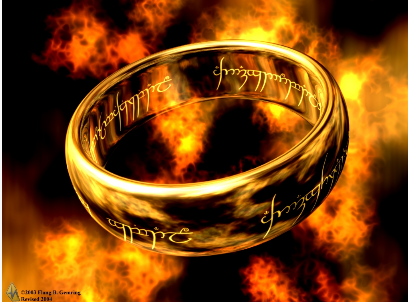 Sauron loses it and years later a river dwelling hobbit finds it. His friend, Smeagol, is overcome with desire for the ring and strangles him to get it. The hobbits banish him and the ring turns Smeagol into Gollum, a vile creature of the dark. He loses his “precious” and Bilbo Baggins finds it. The Trilogy begins when Bilbo realizes that the ring is wearing on him and it’s time to give it to his nephew, Frodo. Gandalf convinces Frodo the take the Ring out of the shire and Frodo begins his journey, pursued by Sauron’s Ringwraiths and fighting against the power of the Ring as it worms its way into his soul. He knows that if it gains power over him, both he and Middle Earth will be lost. During the journey the corrupting effects of the Ring constantly cause tension and strife. Frodo learns that he must destroy the ring by throwing it into the Cracks of Doom where it was forged, but when he finally gets there, the
Sauron loses it and years later a river dwelling hobbit finds it. His friend, Smeagol, is overcome with desire for the ring and strangles him to get it. The hobbits banish him and the ring turns Smeagol into Gollum, a vile creature of the dark. He loses his “precious” and Bilbo Baggins finds it. The Trilogy begins when Bilbo realizes that the ring is wearing on him and it’s time to give it to his nephew, Frodo. Gandalf convinces Frodo the take the Ring out of the shire and Frodo begins his journey, pursued by Sauron’s Ringwraiths and fighting against the power of the Ring as it worms its way into his soul. He knows that if it gains power over him, both he and Middle Earth will be lost. During the journey the corrupting effects of the Ring constantly cause tension and strife. Frodo learns that he must destroy the ring by throwing it into the Cracks of Doom where it was forged, but when he finally gets there, the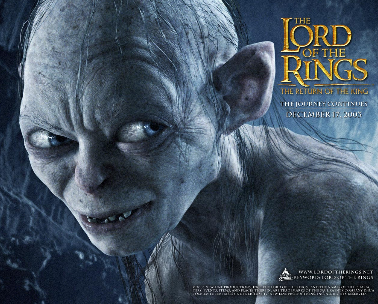
It is the Ring that holds the power and controls the actions of every character in the story, and like The Devil of Monotheism, it is finally sent down to fiery Hell.
The Devil is a necessity in fiction. Without him in the background pulling strings and pushing buttons, and causing troubles, there would be no hero’s journeys to write about.


2 thoughts on “The Major Arcana and the Hero’s Journey: The Devil, Part IV”
My first friend in Tarot used to say that if anyone can make the Devil laugh that person gets a “golden ticket” to Paradise.
The book of Job, reputedly the oldest book in the Bible, contains my second favorite tale with the Devil in it. My most favorite was collected by Zora Neale Hurston, and was published in Of Mules and Men. It’s called “The Keys to the Kingdom, ” and in it, the “Debil” helps Eve obtain the keys to the kingdom from God. A great little read.
My first friend in Tarot used to say that if anyone can make the Devil laugh that person gets a “golden ticket” to Paradise.
The book of Job, reputedly the oldest book in the Bible, contains my second favorite tale with the Devil in it. My most favorite was collected by Zora Neale Hurston, and was published in Of Mules and Men. It’s called “The Keys to the Kingdom, ” and in it, the “Debil” helps Eve obtain the keys to the kingdom from God. A great little read.